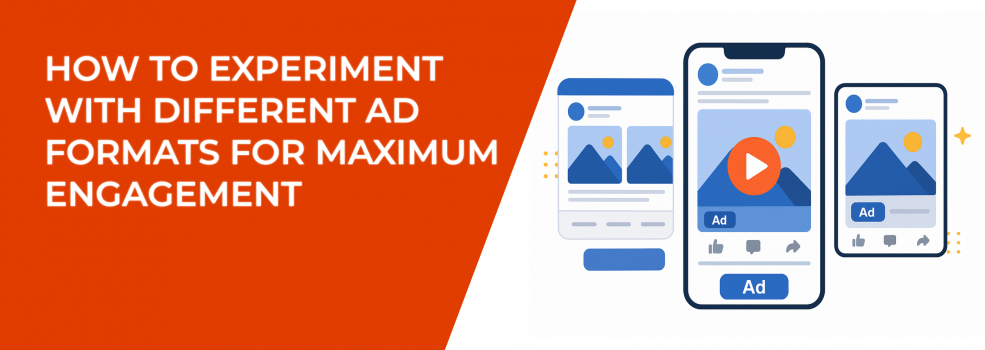Your ad content may be on-brand, well-written, and visually appealing — but if it’s packaged in the wrong format, it may never reach its potential.
Ad format plays a critical role in how users perceive and engage with content. Facebook and Instagram offer a variety of formats — Stories, Reels, carousels, collection ads, single-image posts, and more — each suited to different user behaviors and campaign goals.
To improve engagement, advertisers must be willing to test and adapt. But successful experimentation requires more than just trial and error. It calls for a structured, strategic approach.
Here’s how to experiment with different ad formats — and how to use the results to drive better outcomes.
1. Establish a performance baseline
Before testing anything, evaluate where you are today. This step is often overlooked, but it’s foundational. Without a clear performance baseline, there’s no way to measure improvement or identify patterns.
Actionable tips:
-
Audit recent campaigns by format. Pull performance data from your ad manager — break it down by format to identify which ones currently drive the most reach, engagement, CTR, and conversions.
-
Compare against industry benchmarks if available. Platforms like Meta often publish average ad performance stats per format by industry — use them as a point of reference.
-
Segment by audience. Engagement with formats can vary significantly between age groups, devices, and even regions. Your younger audience might engage more with Reels, while older users prefer static formats.
Ask yourself: What formats are underperforming despite solid creative? Which ones tend to generate longer interaction times? These insights will inform what to test next.
2. Test one format variable at a time
A common testing mistake is changing too many things at once — format, creative, audience, copy. This creates ambiguity in your results. If performance improves, you won’t know why.
Actionable tips:
-
Keep all other variables consistent — audience targeting, budget, placement, copy, and call-to-action — so that the format itself is the only thing you're testing.
-
Use A/B testing tools within Meta Ads Manager. Set up split tests that serve the same creative in different formats to the same audience for clean, comparable data.
-
Limit the testing window to a defined period (e.g., 7–14 days) to reduce outside variables and avoid overlapping campaigns skewing your results.
You’ll get clearer, more reliable data by isolating the format variable. This allows you to optimize with confidence, not guesswork.
3. Align format with funnel stage
Not all formats are designed to serve the same purpose. A key part of experimentation is understanding which formats perform best at each stage of the customer journey.
Actionable tips:
-
Top-of-funnel (Awareness): use short-form videos, Reels, and Stories to introduce your brand. Keep the focus on storytelling, brand personality, and visual impact. Hook viewers in the first two seconds.
-
Mid-funnel (Consideration): carousels, collection ads, and in-depth videos work well here. They let you show multiple products, highlight features, or answer common objections. Structure the flow logically — each carousel card should build on the one before.
-
Bottom-of-funnel (Conversion): focus on clarity. Use single-image ads with compelling CTAs, testimonials, or time-sensitive offers. Ensure your creative leads directly to your landing page or purchase link.
Pro tip: tailor your creative tone as well. Awareness content should spark curiosity. Conversion content should reduce friction and provide certainty.
For a deeper understanding of how campaign objectives influence format choice, explore our guide on Meta Ad Campaign Objectives Explained — it walks you through selecting the right goal for each stage of the funnel.
4. Let the right metrics guide you
Engagement doesn’t mean much unless you define what success looks like. A highly viewed video might not lead to sales. A high click-through rate might not drive revenue.
Actionable tips:
-
Map metrics to goals. If your goal is brand awareness, prioritize impressions and video views. If it's lead generation, track conversion rate and cost per result.
-
Monitor micro-engagements. For carousels, see how many cards are swiped. For videos, track average watch time and completion rate. For Stories, analyze drop-off points.
-
Compare across formats, not just within them. For example, if carousels show lower CTR than Reels but higher time-on-ad, determine which metric matters more for your campaign objective.
Treat your metrics like feedback — they’ll tell you not just what’s being noticed, but what’s actually working.
If engagement looks strong but conversions stay flat, this could signal deeper funnel issues — learn how to troubleshoot that in Facebook Ads Not Converting: How to Fix It.
5. Build a structured testing calendar
Testing works best when it’s systematic. Random, one-off experiments may yield results, but structured testing reveals patterns and long-term insights.
Follow these tips:
-
Create a rolling 90-day testing calendar that allocates time to each major format: video, image, carousel, Stories, Reels. Schedule dedicated time slots for each, and document the objective.
-
Introduce seasonal or promotional tests. During holidays or product launches, run quick format tests to adapt to shifting audience behavior.
-
Include review checkpoints. Every 30 days, analyze test outcomes, archive learnings, and decide whether to scale, adjust, or discard the tested format.
With a clear calendar, testing becomes part of your strategy, not just something you do when performance drops.
6. Optimize creatives for each format
Even the best creative will underperform if it's not tailored to the format it’s placed in. Format isn’t just a container — it influences how your message is perceived.
Check these tips:
-
Design with mobile in mind. Most users experience ads on mobile. Prioritize vertical video for Stories and Reels. Use bold fonts and minimal text that’s legible at a glance.
-
Use native features. Add tap-to-advance prompts in Stories, or leverage swipe-up/CTA stickers. These small tweaks improve user interaction and reduce friction.
-
Adapt visuals for clarity. In carousels, make sure each slide adds value — whether through product variations, testimonials, or problem-solution storytelling.
-
Hook early. For video and Reels, your first two seconds matter most. Use motion, contrast, or a direct question to capture attention.
Always preview your ad as the user would see it and refine until it feels natural in the feed or Story flow.
Want a full breakdown of each format’s strengths, specs, and use cases? Don’t miss The Ultimate Guide to Facebook Ad Formats.
Conclusion
Format testing isn’t just a tactic — it’s a capability. In a landscape where attention is short and competition is high, understanding how to deliver your message is as important as the message itself.
By establishing a baseline, testing with intent, aligning formats to funnel stages, and building a sustainable testing rhythm, you’ll not only improve engagement — you’ll make better decisions, faster.
And when every impression counts, that’s what separates good campaigns from great ones.

